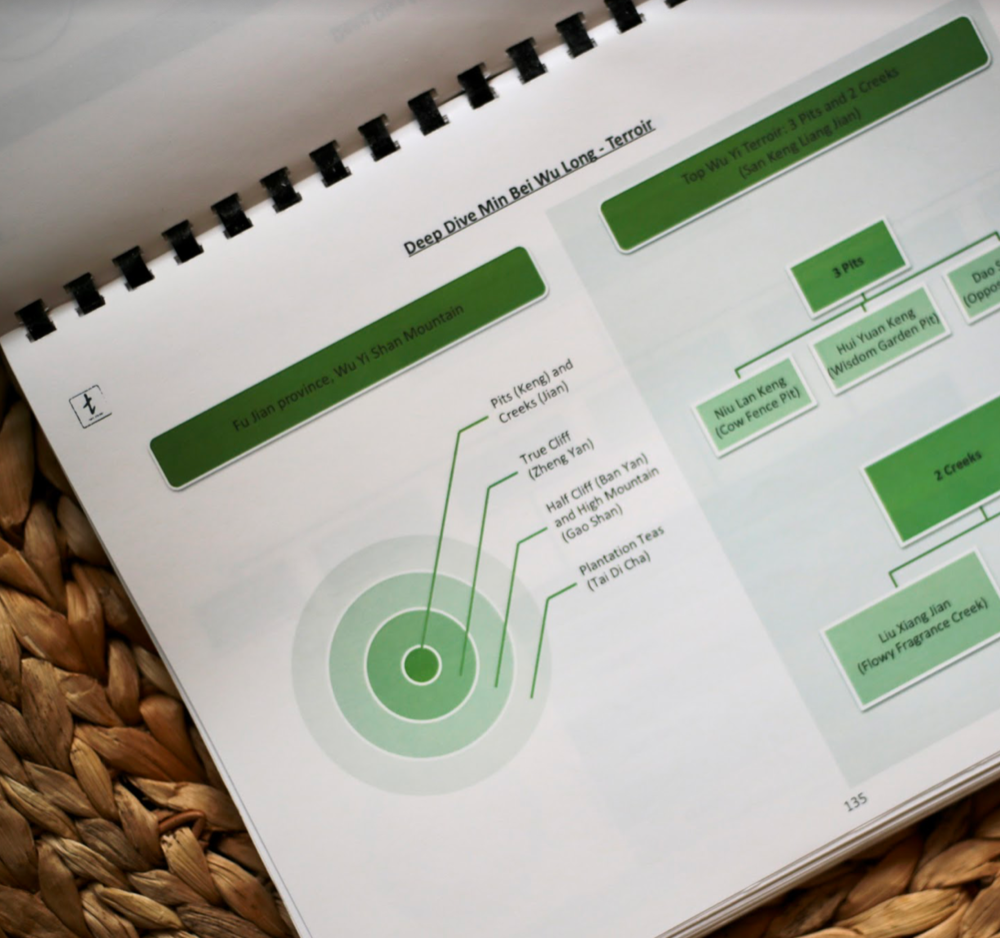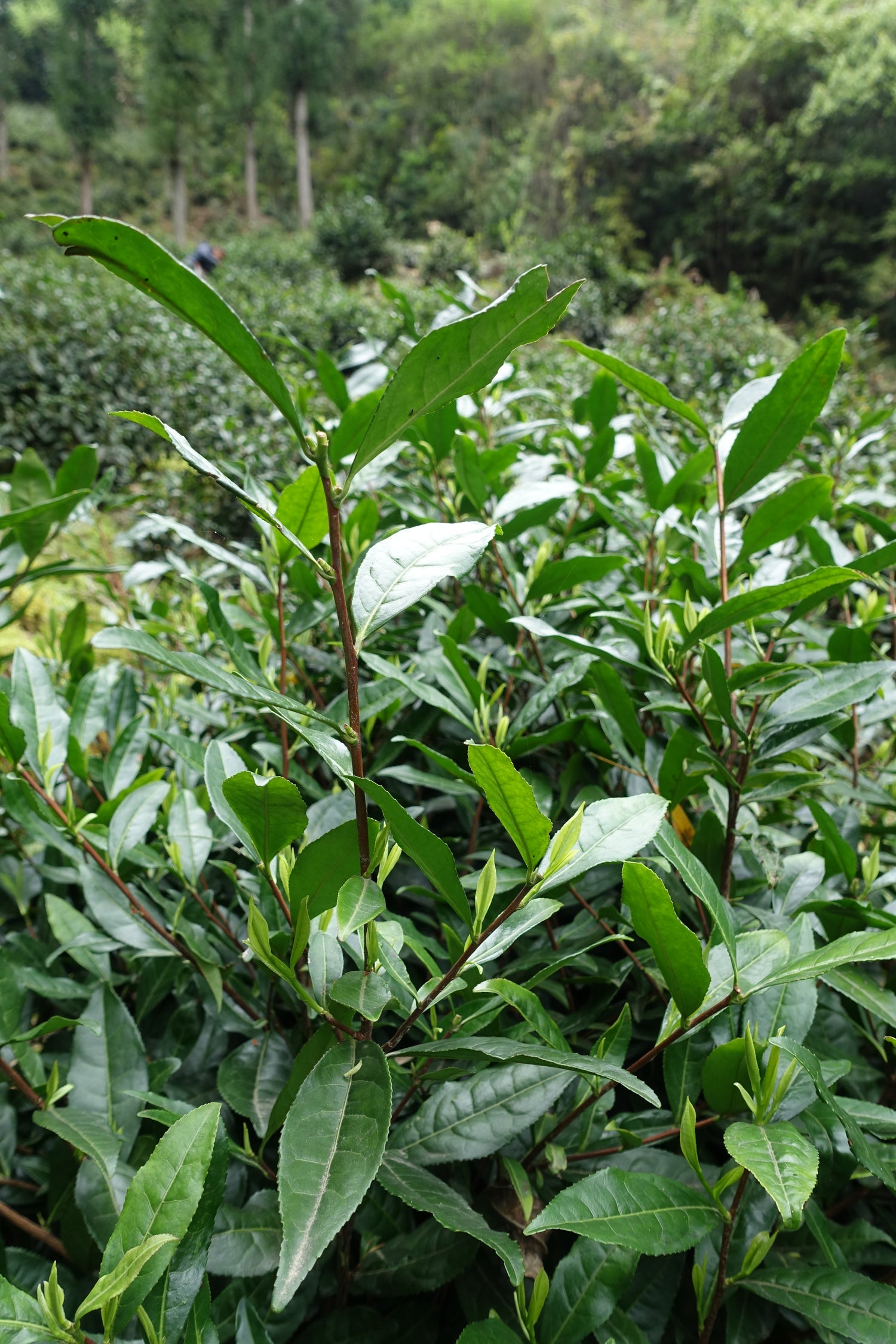Harvesting and Fresh Leaves
Zhu Ya - Still Bud 駐芽: Initial bud at the beginning of the season before rapid growth; or an unhealthy bud that has stopped growing
Dan Ya - Single Bud 單芽: Just one bud
Yi Ya Yi Ye - One Bud and One Leaf 一芽一葉: This refers to the number of leaves harvested
Yi Qiang Yi Qi - One Sword and One Flag一槍一旗: A metaphor for the above term
Yi Ya Er Ye/Yi Ya Liang Ye - One Bud and Two Leaves 一芽二葉、一芽倆葉: This refers to the number of leaves harvested and picking grade, similar to above
Yi Qiang Er Qi - One Sword and Two Flags 一槍二旗: A metaphor for the above term
Yi Ya * Ye: One bud and multiple leaves, etc. This term can be used using any number of leaves that are harvested with just one bud
Chu Zhan - Just Opening 初展: The stage of growth when the buds are just beginning to open
Ban Pian 扳片: Removing a single leaf off the stem/branch
Pian Cha 片茶: Single leaf tea; example: Gua Pian
Kai Mian - Open Face 開面: Once a leaf has opened from a bud to a leaf, below are stages of this process
Xiao Kai Mian - Small Opening/Face小開面
Zhong Kai Mian - Medium Opening/Face中開面
Da Kai Mian - Large Opening/Face大開面
Cha Geng – Stems – 茶梗: Part of the tea plant that typically gets removed in fining depending on picking grade - for pu er we keep, for greens and yellows we pick out
Ma Ti – Horseshoe – 馬蹄: When a young shoot gets pulled off the main too close to the branch and a tiny piece of wood stays attached.
Dui Jia Ye - Opposing Leaves 對夾葉: A sign of malnourishment, appearing when the tea is ending its shoot cycle or when there’s not enough nutrition to keep growing.
Kong Xin Ya - Empty Bud 空芯芽: When a leaf has no bud inside. This issue is often seen in plantation tea, where over-harvesting is common.
Yu Ye - Extra Leaf / Supporting Leaf 余叶/鱼叶: A very tiny leaf that has no veins or taste and should be removed during sorting.
Xian Ye/Cha Qing – Fresh Leaves – 鮮葉/茶青: What the tea leaves are called as soon as they are harvested before any processing is done, this is not tea yet
Qing – Green/Fresh Leaves – 青 - a prefix used in many terms to talk about the tea leaves before they are tea
Processing
Tan Fang – Resting - 攤放: Letting fresh tea leaves rest to lose surface moisture before processing. Typically applicable to green and yellow teas.
Wei Diao – Wilting – 萎凋: Letting fresh leaves rest to lose moisture and increase enzyme activities to prepare for fermentation. Typically applicable to white tea, wu long, and red teas.
Ri Guang Wei Diao – Sun Wilting - 日光萎凋
Shi Nei Wei Diao – Indoor wilting/shaded wilting - 室内萎凋: When wilting/shaded wilting is done indoors
Sha Qing - Kill Green – 殺青: the step to apply high heat to wet leaves to stop enzyme reactions, applicable to green tea, yellow tea, Yan Cha, and Dan Cong.
Zuo Xing – Shaping – 做型: a deliberate step to make tea into a particular shape, applicable to all teas except for white and black teas.
Hong Gan – Bake to Dry – 烘乾: baking tea leaves from wet to dry
Hong Qing – Baked dry green tea - 烘青
Ti Xiang – Enhance Aroma – 提香: A step to bake already dried tea carefully to solidify notes, repel impurities and enhance the aroma. This step enhances but does not alter the tea's flavor and should not be confused with roasting.
Men Huang – Yellowing Method - 悶黃: a yellowing method where the teas are wrapped, typically with porous paper, wax paper or plastic bags, applicable to yellow tea
Tan Huang – Yellowing Method - 攤黃: a yellowing method where the teas are laid evenly in a tray (usually bamboo) and covered with a damp cloth, applicable to yellow tea
Shai Qing – Sun Dried Green Tea - 曬青
Ri Shai - Sun Drying - 日曬
Yao Qing / Lang Qing – Shaking – 搖青/浪青: a critical step in making traditional wu long tea where the wilted leaves are physically disturbed by being shaken or flipped to distribute water in the leaves and facilitate fermentation.
Shou – Hand – 手: a jargon used to refer to when the tea has been shaken. For example, the third time tea is being shaken would be referred to as the third hand; if a tea is made with seven shaking times, one would say the tea took seven hands.
Zuo Qing – Making Green – 做青: the entire steps to facilitate the fermentation of wu long tea, including shaking and the resting in between.
Zou Shui - Water Traveling – 走水: a jargon used to describe internal moisture movements inside of tea leaves during the shaking and fermentation of wu long, but the terminology is increasingly used for other categories of teas
Ji Shui – Water Congestion – 積水: a jargon used to describe too much moisture of the tea rushing to the leaves, usually due to excessive shaking on tender leaves, causing dead leaves.
Si Qing/Si Ye – Dead Leaves – 死青/死葉: a jargon referring to undesired leaves during tea processing where the leaves have turned brown or red color. These leaves usually have lost their enzyme activities and no longer react to further processing steps. The fault can happen due to improper or excessive wilting or fermentation in red, white, and wu long. Si Qing could cause discoloration and bitterness in tea.
Rou Nian – Rolling - 揉捻: rolling to tighten the tea strings, squeeze some tea juices out and layer the flavors, an essential step for wu long, red tea and pu er and applicable to some green, yellow, and black teas.
Cha Zhi – Tea Juice – 茶汁: typically referring to juices coming out of tea leaves during processing, such as rolling. This action is not to be confused with tea's liquor during extraction, such as when steeping the tea.
Duan Geng – Snapped Stems – 斷梗: this is a jargon typically used during red tea making while testing if the wilted leaves are ready for rolling. If one can fold the stem of a tea between fingers without snapping it, then the tea is ready for rolling.
Hong Bei/Bei Huo - Roasting – 烘焙/焙火: baking dried tea leaves at a very low temperature over an extended period to enhance the aroma and body of the tea. This step gives traditional wu long its roasted flavor.
Shang Bei – Start Roasting - 上焙
Xia Bei – Stop Roasting - 下焙
Da Bei – Making the Roasting Pit - 打焙: usually referring to traditional roasting using charcoal ashes.
Bei Keng – Roasting Pit - 焙坑: usually referring to traditional roasting using charcoal ashes.
Tui Huo – Resting - 退火: specifically letting the tea rest between roasting and before drinking, typically for three weeks. It applies to all teas when referring to letting finished tea rest for three weeks before drinking.
Guo Hong Guo - 過紅鍋: an optional step in making red tea where the fermented leaves are briefly applied high heat to dissipate moisture and solidify the fermentation quickly.
Hua Tiao – Discoloration - 花條: in tea leaves can refer to both work-in-progress leaves and finished teas
Tiao Hua Tiao/Jian Hua Tiao – 挑花條/撿花條: a jargon referring to the optional step during primary tea processing where one can sort out the discolored leaves, lessening the effect of Si Qing. This step is typically done to white teas and wu long throughout primary processing as the tea maker sees fit and red teas after fermentation but before drying where the discoloration is easier to identify.
Wo Dui – Piling – 渥堆: a technique to increase the temperature and moisture level of the tea leaves by piling a large amount of them together, an essential step for black tea and sometimes applicable to white tea.
Tiao Suo – Tea String – 條索: a jargon used to describe rolled tea
Jin Shi – 緊實: a jargon to describe tight or elastic tea strings
Pao/Pao Tiao – 泡/泡條: a jargon to describe loose or less elastic tea strings
Chu Zhi – Primary Processing of tea - 初制
Mao Cha – Rough Tea – 毛茶: a jargon referring to dried but unfinished tea. As long as there are still steps to be applied to the dried leaves, it can be called Mao Cha. Mao Cha is the product of Primary Processing.
Cheng Cha - Finished tea - 成茶
Jing Zhi – Fining steps in processing tea - 精製
Jing Zhi Cha – Finished Tea - 精製茶: tea that has gone through a fining process.
Tiao Geng/Jian Geng – Picking Stems – 挑梗/撿梗: a jargon referring to picking out unwanted twigs, stems, and yellow leaves
Huang Pian – Yellow Leaves – 黃片: leaves too mature to be desired for the Finished Tea. Mature leaves, when dried, usually have a lighter color than desired leaves, hence the term yellow leaves.
Shai Cha – Shai Xuan – 篩茶/篩選: an essential step throughout the processing of high-end tea and especially at the beginning of the fining process where the tea is sorted and sifted for uniformity. Tiao Geng is a typical step; it could be sifting out bitsy leaves for some other teas.
What Can Go Wrong During Processing:
Hong Geng – Red Stems – 紅梗: a jargon referring to undesired oxidation during tea processing, causing the tea to turn red or brown color, usually starts to show in stems first but can also happen in leaves.
Chou Qing - Stinky Green – 臭青: a general term used to describe a range of undesired smells and notes in faultily processed teas. It usually smells like rotten greens and can be caused by various reasons such as over wilting, insufficient fermentation, etc.

What's The Tea Drunk Academy?
The Tea Drunk Academy is a course-driven platform where we host our past guided tasting videos from our Educational Tea Club, webinar series, and educational materials. Whether you’re just starting your tea education or have been an active member of the Tea Drunk community for years, we recommend taking a look at this curriculum from the starting point. Each offering gets a bit more granular as you progress, but having a solid foundational knowledge of tea and its history is so vital to your experience with the leaves.

